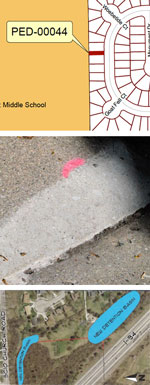Oct. 21, 2013 Ann Arbor Council: Final
The Oct. 21, 2013 meeting of the Ann Arbor city council is the last one before the Nov. 5 election. After the election, the current group of councilmembers will have just one more meeting, on Nov. 7, before the new council is seated. The agenda the current council faces on Oct. 21 is relatively heavy.

The sign on the door to the Ann Arbor city council chamber, installed in the summer of 2013, includes Braille.
It’s possible that the council might be briefed at the meeting on proposals received by the Oct. 18 deadline for the purchase of the city-owned parcel on William Street between Fourth and Fifth avenues (the former Y lot), but that’s not yet clear. The property had been listed for $4.2 million.
Many of the Oct. 21 items already on the agenda can be divided into three main categories: transportation, the Ann Arbor Downtown Development Authority, and the city’s energy commission.
The council held a work session about transportation on Oct. 14, 2013. Transportation-related items on the Oct. 21 agenda include a resolution that would admit Ypsilanti Township as a member of the Ann Arbor Area Transportation Authority. The specific question to be considered is a revision to the AAATA’s articles of incorporation – which would also expand the number of board members from nine to 10.
A second transportation-related agenda item is a city-led initiative to develop a new train station, with the location to be determined. The existing location, as well as one on Fuller Road near the University of Michigan medical campus, would be among the possibilities. On the council’s agenda is a contract with URS Corp. to conduct an environmental review that would include public engagement, site selection and conceptual design. The council’s authorization would be $824,875, an amount that includes a $63,083 contingency. The city would pay 20% of that, or about $165,000, with the rest covered by a federal grant that has already been awarded by the Federal Rail Authority.
To the extent that pedestrian infrastructure is also part of the city’s transportation system, a transportation-related pair of items would alter the definition of “sidewalk” to include cross-lot walkways. Affected by the change, for example, would be walkways that connect streets with parks or school property. The change would allow for use of sidewalk repair millage funds to repair cross-lot walkways, without triggering the winter maintenance requirement for adjacent property owners.
Finally, the city council will be asked to approve an annual resolution related to wintertime transportation – the purchase of ice control salt for city streets.
Related to the Ann Arbor DDA are three items: (1) reconsideration of the appointment of Al McWilliams to the board of that authority – likely to be confirmed on a re-vote, if reconsideration is approved; (2) final consideration of a change to the city ordinance regulating the DDA’s TIF (tax increment financing) capture – likely to be postponed yet again; and (3) a budget allocation of $280,000 to cover costs associated with replacement of downtown ornamental, pedestrian-scale light poles. The DDA is contributing $300,000 to the cost of the $580,000 project. Some councilmembers think the DDA should pay for the full amount, so the eight-vote majority required for the budget amendment might not be achieved.
The specific size of the majority vote required could also be a factor in one of two agenda items related to the city’s energy commission – the re-appointment of Wayne Appleyard to the commission. The confirmation will need a seven-vote majority under the city charter, because he’s not a city resident. The other energy-related item is an energy commission-recommended resolution – which was previously rejected, reconsidered and postponed by the city council. The resolution would call upon the city’s employee retirement board to divest from fossil fuel companies.
This article includes a more detailed preview of each of these agenda items. More details on other meeting agenda items are available on the city’s online Legistar system. Readers can also follow the live meeting proceedings Monday evening on Channel 16, streamed online by Community Television Network.
The Chronicle will be filing live updates from city council chambers during the meeting, published in this article below the preview material. The meeting is scheduled to start at 7 p.m. [Full Story]





